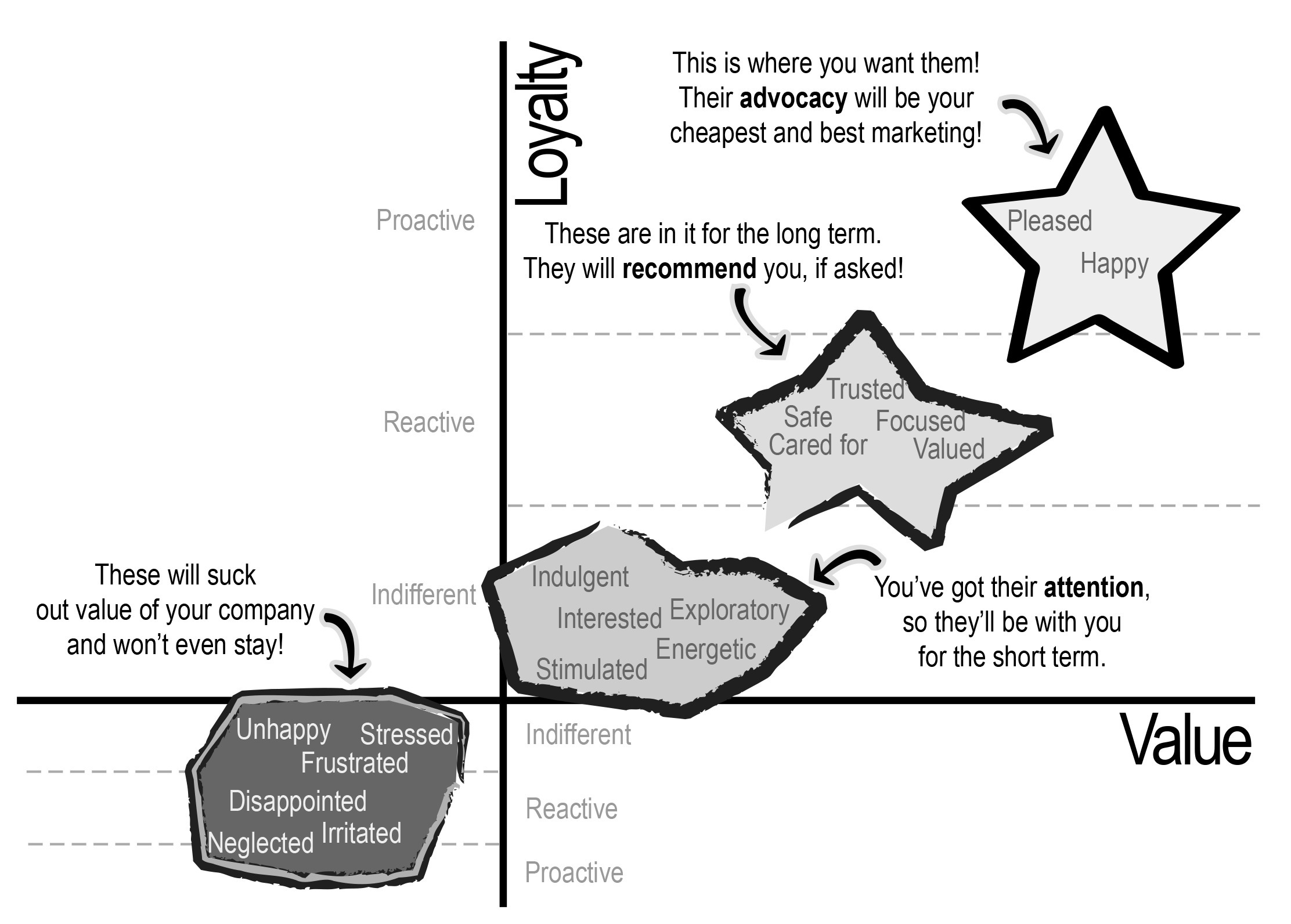How do your customers feel about your company and the service you provide? Are they frustrated, energetic, focused, or just happy? Translate their emotions into how much value they will bring to your business and how loyal they are. How do you want your customers to feel, and how do you get them there?
Toward building engaging customer relations
Blog post by Anders Toxboe on

Emotional states of your customer and how they relate to their value and loyalty.
The worst emotions your customers can have toward you are those of discomfort. Are they stressed because the product they ordered last week has not shown up yet? Are they frustrated because they fail to figure out how to place an order? Or do they feel neglected and irritated when customer service is either too slow or gives the answer they feared?
Customers with emotions of discomfort can destroy your business. On the short term however, it is your support team that will hurt the most, as customers with these emotions will return their products and call in with complaints. In the long term, these are the customers who could destroy your brand by either reactively or proactively communicating to other people how much you suck! Customers with emotions of discomfort can be your worst nightmare!
Marketing in the old days before the internet came along was all about attention. By investing money in TV, newspaper, billboard advertisement and similar mass-marketing channels, you placed a bid for for the customer’s attention. If you poured enough money into the funnel, you would win the auction and the money spend would be translated into sales. Those times are gone.
Teach! Teach about how you can help them kick ass!
When you get the attention of new customers, they are interested in what you can offer them. You might even convert their interest into short-term sales. But more importantly, the odds of building a long-lasting relationship with the customer have been increased a notch. They are indifferent to your brand and product, but have a momentum of energy. Use their energy and explorative excitement to let them learn about you. Teach! Teach about how you can help them kick ass!
Once you have build a relationship to your customer that you are both fond of, the customer will recommend you if asked. They like you! Even better, they will come back for more! If they feel valued, have trust in you, and feel cared for, they will reward you with plentiful business. They will come back again and again, yielding returns much larger than the one-time fix you got from getting their one-time attention. Customers with emotions corresponding to this stage will recommend you if somebody asks. They are reactive rather than proactive.
If loyalty is your goal, you want to turn your customers into your ambassadors. In this state, your customers will advocate your products and proactively tell other potential customers about your products. This is the ultimate end-goal for word-of-mouth marketing: it’s the cheapest and possibly best marketing there is.
Notice the three levels of engagement used: indifferent, reactive, and proactive. Just as there are three levels of engagement on the positive side of the graph, there are also three levels on the negative side. There is however one big difference: Proactive behavior from customers with negative or destructive emotions toward you will be provoked much sooner and more frequent than customers with positive and pleased emotions. People are more bound to blog, speak, or engage with you when they feel angry, neglected, and are upset than if they are happy.
This post was inspired by the 1999 Seth Godin book, Permission marketing, which is about getting permission to build a relationship to your customer instead of just interrupting their attention constantly. The cluster idea and emotional states was greatly inspired by The DNA of customer Experience by Colin Shaw. Also, Kathy Sierra deserves some love for the now closed Creating passionate users blog. Finally, there’s also a splash of the Prospect theory and the value function.
Sources
Permission marketing by Seth Godin
The DNA of customer Experience by Colin Shaw
Creating passionate users by Kathy Sierra
Prospect theory and the value function at wikipedia.org.
1 comment
Web Application design on Aug 28, 2009
If that were the right word to use, I’ll say that this blog is “kick ass”. What real worl examples and what a spot on advice.
Comments have been closed